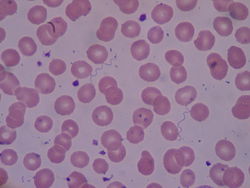Difference between revisions of "Spirochaetes species - Overview"
Jump to navigation
Jump to search
| (8 intermediate revisions by 2 users not shown) | |||
| Line 1: | Line 1: | ||
| − | {{ | + | {{unfinished}} |
| − | |||
| − | |||
| − | |||
| − | |||
| − | |||
| − | |||
| − | |||
| − | |||
| + | {| cellpadding="10" cellspacing="0" border="1" | ||
| + | | Also known as: | ||
| + | | '''Spirochetes''' | ||
| + | |- | ||
| + | |} | ||
| + | [[File:spirochaetes.jpg|right|thumb|250px|<small><center> Spirochaetes in blood smear of human subject. (Bobjgalindo 2009, Wikimedia commons)</center></small>]] | ||
==Overview== | ==Overview== | ||
| − | |||
There are two families, ''[[:Category:Leptospiraceae|Leptospiraceae]]'' and ''[[:Category:Spirochaetaceae|Spirochaetaceae]]''. | There are two families, ''[[:Category:Leptospiraceae|Leptospiraceae]]'' and ''[[:Category:Spirochaetaceae|Spirochaetaceae]]''. | ||
''Leptospiraceae'' include the pathogens of the genus, ''[[Leptospira]]'', whereas ''Spirochaetaceae'' include the pathogens of the genera ''[[Borrelia]]'' and ''[[Brachyspira hyodysenteriae|Brachyspira]]''. Spirochaetes may cause zoonotic infections. | ''Leptospiraceae'' include the pathogens of the genus, ''[[Leptospira]]'', whereas ''Spirochaetaceae'' include the pathogens of the genera ''[[Borrelia]]'' and ''[[Brachyspira hyodysenteriae|Brachyspira]]''. Spirochaetes may cause zoonotic infections. | ||
| Line 16: | Line 13: | ||
==Characteristics== | ==Characteristics== | ||
''Spirochaetes'' are spiral or helical Gram-negative bacteria. They are motile organisms as they have endoflagella. The position of their flagella is used to distinguish this bacteria, they run length ways and cause a twisting motion. They have lengths between 5 and 250 µm. They are sensitive to dessication and survive poorly in the environment. | ''Spirochaetes'' are spiral or helical Gram-negative bacteria. They are motile organisms as they have endoflagella. The position of their flagella is used to distinguish this bacteria, they run length ways and cause a twisting motion. They have lengths between 5 and 250 µm. They are sensitive to dessication and survive poorly in the environment. | ||
| + | |||
==Diagnosis== | ==Diagnosis== | ||
They stain poorly with Gram stain as most require specialised media for growth. Serology is required for their identification. | They stain poorly with Gram stain as most require specialised media for growth. Serology is required for their identification. | ||
| − | |||
| − | |||
| − | |||
| − | |||
| − | |||
| − | |||
| − | |||
| − | |||
| − | |||
| − | |||
| − | |||
| − | |||
| + | [[Category:To_Do_-_AimeeHicks]] | ||
[[Category:Spirochaetes]] | [[Category:Spirochaetes]] | ||
| − | |||
Revision as of 10:48, 20 July 2010
| This article is still under construction. |
| Also known as: | Spirochetes |
Overview
There are two families, Leptospiraceae and Spirochaetaceae. Leptospiraceae include the pathogens of the genus, Leptospira, whereas Spirochaetaceae include the pathogens of the genera Borrelia and Brachyspira. Spirochaetes may cause zoonotic infections.
Characteristics
Spirochaetes are spiral or helical Gram-negative bacteria. They are motile organisms as they have endoflagella. The position of their flagella is used to distinguish this bacteria, they run length ways and cause a twisting motion. They have lengths between 5 and 250 µm. They are sensitive to dessication and survive poorly in the environment.
Diagnosis
They stain poorly with Gram stain as most require specialised media for growth. Serology is required for their identification.
